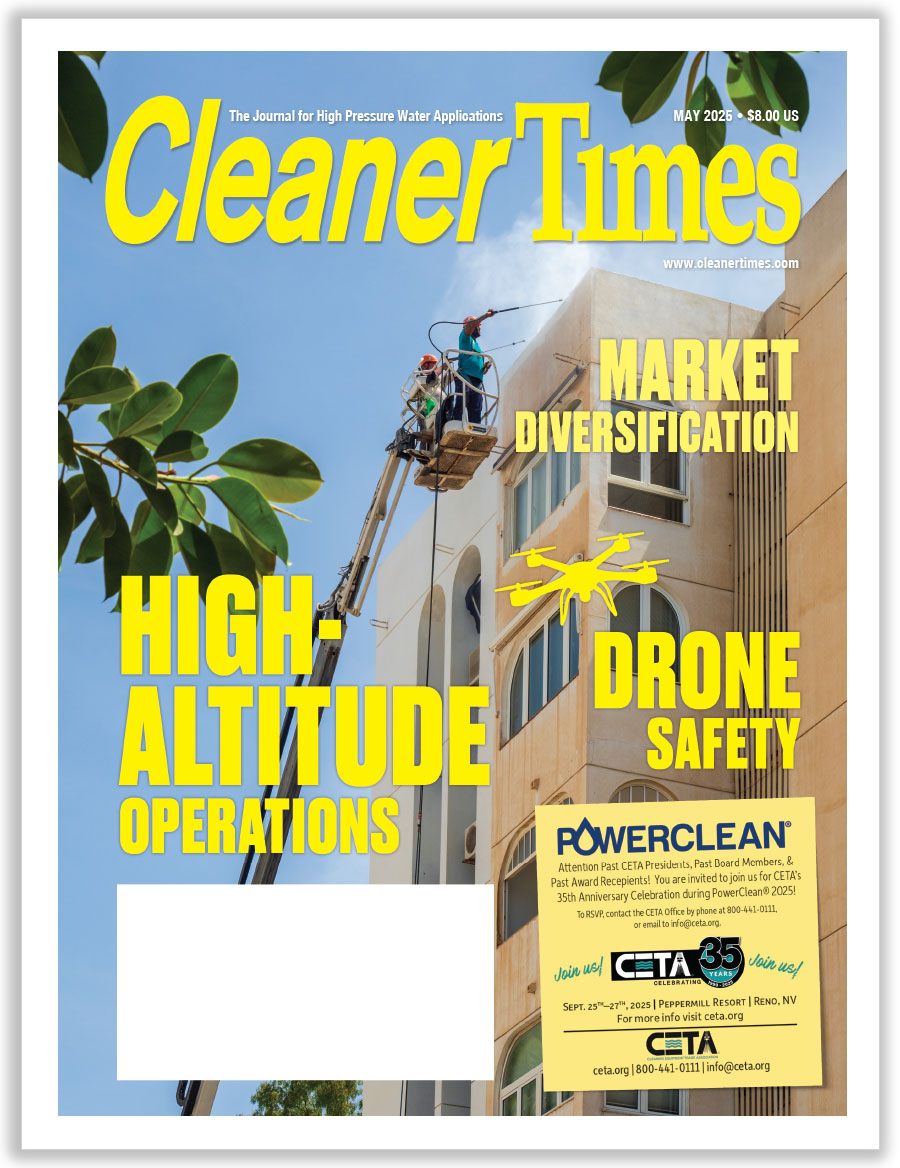
Securing Your Equipment
Take Care of the Essentials
By Diane M. Calabrese / Published March 2019

Carefree? Not experiencing the least bit of doubt or anxiety? Unlikely.
If it’s a normal day, there will be a concern or two in the picture. Things happen.
Wholly preventable things, however, should not happen. And for the most part, it’s possible to secure equipment so that it does not walk away, break free, or simply stop running.
Equipment protected from theft, damage through dislocation (in transit or in use), and deterioration (through improper maintenance) is secure to the fullest extent possible. As such, securing equipment is a multipart task.
The effort begins with taking time to do the essentials day in and day out. “I believe that anything that is easy to pull off a truck makes it a target for theft,” says Jamie Schmidt, president of GreenWay Pressure Washing in Cherry Hill, NJ.
“We make sure all of our equipment is bolted, and any surface cleaners, ladders, etc., are locked with a hard-to-cut chain,” explains Schmidt. “I would recommend that all contractors secure their equipment to make theft harder for the thieves to accomplish.”
Some precautions are learned through experience. Schmidt says he once had a surface cleaner stolen because it was not locked down. That made it easy to grab.
“My biggest theft was when one of our trucks was stolen,” says Schmidt. “We made the mistake of leaving a key hidden under the seat for one of our night techs. There were some guys going around breaking into vehicles to steal whatever they could; they found our keys.”
Schmidt’s truck was not gone for long. “Thankfully, the thieves were caught the same day trying to take the equipment off the truck.”
The theft and its quick resolution also served as a significant reminder. “We learned a valuable lesson that day—never to leave a key hidden again,” says Schmidt.
Talking with colleagues and competitors is a good way to assess whether there might be places to bolster security for equipment. Talking with an insurance carrier is another good way to identify weak spots in security.
Each type of job site carries unique risks. Consequently, it’s not possible to predict whether vehicles, equipment, or ancillaries will be the greatest target of theft over time.
“Due to the nature of a contractor’s operation, exposure to loss changes from job to job,” says Rikki Lee Con-cannon, manager and new business marketing at CSC Insurance in South Rostraver, PA.
Irrespective of type of loss, a theft can affect the cost of insurance. “An insured’s loss history can adversely impact not only their pricing but also their ability to obtain quotations within the standard marketplace,” says Concannon.
Information from one national carrier illustrates the connection, explains Concannon. The carrier requires the applicant for insurance to have no more than two losses during the prior three years or no single loss greater than $10,000 during the prior three years.
Take advantage of advice from carriers. “Many carriers offer risk management services at very little cost or for free to their customers,” says Concannon. “Some carriers offer discounts to their customers for utilization of industry-related risk management services.”
Risk management does more than just identify ways to prevent incidents. “An insured’s commitment to their own risk management not only aids in the claim process; it reduces their exposure to future losses,” says Concannon.
Concannon shares some of the advice her company gives to its clients: “We recommend establishing an enforced theft-prevention policy, ensuring your employees and subcontractors are aware of the policy. Maintain an up-to-date inventory of your equipment, tools, and materials, and create a daily log to verify that everything is accounted for at the end of each workday. Secure your site at the end of each day.”
Being able to account for everything at the end of each day is one of the fundamentals of safe work practices, practices that have a way of linking the dimensions of a business together. Yes, any theft would be detected quickly. At the same time, properly stowed machines and tools improve efficiency, as no one has to ask where something is.
Methodical storage procedures protect equipment and employees. That includes storage in vehicles in which machines must be tethered and tools contained. (An orderly and clean vehicle also impresses passersby who can’t resist looking in an open door, making it a good advertisement.)
At job sites, equipment is secure when there is no chance of a contact with a non-team member. It can’t roll. Hoses are contained. And so on…
Machines, Vehicles, and More
Take the time to secure equipment. Never be so hurried or exhausted as to take the just-this-once approach—whether it means putting a machine in a van without tethering it or leaving a machine unattended at a job site. It’s genuinely the case that an ounce of prevention is worth a pound of cure.
Be sure to have identifiers on machines. They help with reclaiming a recovered machine. They also make it more difficult—but not impossible—for a thief to sell a stolen machine.
There are as many recommendations for how to put an identifier on a machine as there are experts in loss prevention. Fitting machines with die stamps, non-removable seals, welded names and numbers, LoJack, and other locator devices are some of the suggestions.
In some high-theft areas, contractors who must leave equipment, such as lifts, on site overnight use devices that disable fuel or electrical switches. Wheel locks are another method used to keep a machine or a vehicle safe.
For contractors with a fleet of vehicles, a fenced and gated and perhaps even guarded storage area is a realistic approach to security. Lighting, cameras, and alarm systems all make it more difficult for thieves.
Risk reduction is always a balancing act and often a precarious one. Dogs and firearms may be legal assists to security. If there is an incident involving a bite or a gunshot, though, the person who was just trying to protect his equipment may have to deal with a liability issue.
Options for protecting vehicles include locks, alarms, steering column immobilizers, locks on brake pedals or steering wheels, and tracking systems. Parking a vehicle in a location where a theft is less likely to occur—not isolated, lighted at night—is a big security enhancer.
Computers and phones must also be protected. If stolen, this is a major inconvenience. Worse, the loss may be compounded by a thief gaining access to sensitive or monetary information stored on the device.
Avoid automatic logins—that’s a given. Consider using some kind of dual entry system for a device. It could be a monitor on something like a pocketed key chain. If your phone or tablet is accessed while it is not in range of the monitor (i.e., not in range of you), it would sound a severe alarm or lock down.
There’s a bit of sadness in every discussion of security that involves misappropriation. We wish we could trust everyone. The wish is a good place to begin. Try to get to know prospective hires so that it will not be necessary to worry about in-house origins of theft.
Sad or not, file a police report when something is stolen. Although it’s unlikely to lead to recovery of a small machine or ancillary, police do aggregate data to determine where there are clusters of incidents, and they analyze clusters as they allocate patrols and shift the patrols around.
As for the dislocation portion of security, think beyond the interior of a vehicle and the correct hitch for any trailer. Ladders, scaffolds, and any rigging must be resistant to dislocation. Follow security protocols every time.
Routine maintenance prevents equipment and tools from deteriorating. It’s a major part of protecting equipment. Another big part is a commitment to use equipment only as its manufacturer intended it to be used.
Having a plan for storing equipment in the event of an impending natural disaster is important. There might not be time to actualize it, but at least it’s ready if time permits. For contractors or other members of the industry with storage areas built on flood plains or along a coast, a plan for moving machines to higher ground should be part of any disaster plan.
Midway between “overwhelmed by” and “blissfully unaware of” the possibility equipment might be lost to service because it was not secured is the spot where most contractors dwell. They take a common-sense approach.
Deter thieves who would walk away with equipment, but do not become so consumed with anti-theft strategies that a job site or a business resembles a secured missile silo.
Take the time to properly store equipment and tools. If a weary brain suggests skipping the effort, recall how long it took to find a tool the last time it was not returned to its storage space.
Follow maintenance schedules. The machine will serve longer and more reliably.
As an added bonus, common sense also tells us that workplace safety gets a huge boost from efforts to secure equipment.





